What’s Up?
I led a Sunday morning GNPA EXPO photo workshop to Jekyll Point on Sunday. We enjoyed a second lovely clear, orange-glow sunrise. Eric Bowles put the group in the perfect spot for tidal pool-scapes. It was windier than last time, so the 8-second or so shutter speeds yielded some really neat patterns in the water. Then we headed a bit farther south to the point proper and did flock and incoming flight silhouettes. With the bright sun and a NW breeze, we were pretty much done by 8:15am so we talked about tripods and heads for a while before heading home.
The post-GNPA EXPO IPT began on Sunday afternoon. We headed to Jekyll Point in less than ideal conditions: clear skies with a southeast wind. We worked hard, worked bit off sun angle to parallel the subjects, and got lucky right before sunset with some birds square to the gorgeous light.
Today is Monday 11 April 2022. The forecast for the morning is for a SW breeze and clear skies. That is pretty good for Jekyll Point so that is where we will be headed. Wherever you are and whatever you are doing, I hope that you too have a great day. This blog post took about an hour to prepare and makes thirty-one days in a row with a new one.
Please remember to use the B&H and Amazon links that are found on most blog pages and to use the BIRDSASART discount code at checkout when purchasing your new gear from Bedfords. Please, also, consider joining a BAA IPT. You will be amazed at how much you will learn!
And Please Remember
You can find some great photo accessories (and necessities, like surf booties!) on Amazon by clicking on the Stuff tab on the orange/yellow menu bar above. On a related note, it would be extremely helpful if blog-folks who, like me, spend too much money on Amazon, would get in the habit of clicking on the Amazon logo link on the right side of each blog post when they shop online. As you might expect, doing so will not cost you a single penny, but would be appreciated tremendously by yours truly. And doing so works seamlessly with your Amazon Prime account.
Please remember that if an item — a Delkin flash card, or a tripod head — for example, that is available from B&H and/or Bedfords, is also available in the BAA Online Store, it would be great, and greatly appreciated, if you would opt to purchase from us. We will match any price. Please remember also to use my B&H affiliate links or to earn 3% cash back at Bedfords by using the BIRDSASART discount code at checkout for your major gear purchases. Doing either often earns you free guides and/or discounts. And always earns my great appreciation.
Brand-New and As-Good-As-Ever Bedfords BAA Discount Policy
Folks who have fallen in love with Bedfords can now use the BIRDSASART coupon code at checkout to enjoy a post-purchase, 3% off-statement credit (excluding taxes and shipping charges) on orders paid with a credit card. The 3% credit will be refunded to the card you used for your purchase. Be sure, also, to check the box for free shipping to enjoy free Second Day Air Fed-Ex. This offer does not apply to purchases of Classes, Gift Cards, or to any prior purchases.
Money Saving Reminder
Many have learned that if you need a hot photo item that is out of stock at B&H and would like to enjoy getting 3% back on your credit card along with free 2nd Day Air Fed-Ex Air shipping, your best bet is to click here, place an order with Bedfords, and enter the coupon code BIRDSASART at checkout. If an item is out of stock, contact Steve Elkins via e-mail or on his cell phone at (479) 381-2592 (Central time). Be sure to mention the BIRDSASART coupon code and check the box for Free Shipping. That will automatically upgrade to free 2nd Day Air Fed-Ex. Steve has been great at getting folks the hot items that are out of stock at B&H and everywhere else. The waitlists at the big stores can be a year or longer for the hard-to-get items. Steve will surely get you your gear long before that. For the past year, he has been helping BAA Blog folks get their hands on items like the SONY a 1, the SONY 200-600 G OSS lens, the Canon EOS R5, the Canon RF 100-500mm lens, and the Nikon 500mm PF. Steve is personable, helpful, and eager to please.
Important Note
As an Amazon Associate, I earn a small percentage when you purchase from Amazon after using any of the Amazon links on the blog (including the logo-link immediately above). My link works with Amazon Prime and using it will not cost you a single cent. Huge thanks, BTW 🙂
Please Remember Also
Please, if you enjoy and learn from the blog, remember to use one of my two affiliate programs when purchasing new gear. Doing so just might make it possible for me to avoid having to try to get a job as a Walmart greeter and will not cost you a single penny more. And if you use Bedfords and remember to enter the BIRDSASART code at checkout, you will (still!) save 3% on every order and enjoy free second-day air shipping. In these crazy times — I lost about fifty thousand dollars in income due to COVID 19 — remembering to use my B&H link or to shop at Bedfords will help me out a ton and be greatly appreciated. Overseas folks who cannot order from the US because of import fees, duties, and taxes, are invited to help out by clicking here to leave a blog thank you gift if they see fit.


Gear Questions and Advice
Too many folks attending BAA IPTs and dozens of photographers whom I see in the field and on BPN, are–out of ignorance–using the wrong gear, especially when it comes to tripods and more especially, tripod heads… Please know that I am always glad to answer your gear questions via e-mail. If you are desperate, you can try me on my cell at 863-221-2372. Please leave a message and shoot me a text if I do not pick up.
|
|
|
This image was created on 8 April 2022 at Jekyll Point, Jekyll Island, GA. I used the hand held Sony FE 200-600mm f/5.6-6.3 G OSS lens (at 200mm) and The One, the Sony Alpha 1 Mirrorless digital camera. ) The exposure was determined using Zebra technology with ISO on the Thumb Dial. ISO 640 1/2500 second at f/6.3 (wide open) in Manual Mode. AWB at 6:42:37pm on a clear afternoon. RawDigger showed the exposure to be perfect. Tracking: Spot S AF-C with Bird Face/Eye Detection performed perfectly. Be sure to click on the image to enjoy a high-res version. Image #1: Black Skimmer and Laughing Gull S-curved flock
|
S-Curved Flock
I worked this flock for about twenty minutes as it blasted off and re-landed on the beach. When I saw the S-curve I used Tracking: Single Spot and moved it to the lower right corner of the frame so that I could focus on the closest bird, the forward-most skimmer in the lower right portion of the frame. When I saw the Laughing Gull in flight over the ocean, I created several images and chose the one with the best wing position. The pano crop was an obvious choice. I like creating this type of image wide open so that sharp focus falls off in the distance and gives a sense of depth to the flock.
Tip: when photographing flocks of birds, it is almost always best to focus on the closest bird.
|
|
|
This image was also created on 8 April 2022 at Jekyll Point, Jekyll Island, GA. I used the hand held Sony FE 200-600mm f/5.6-6.3 G OSS lens (at 430mm) and The One, the Sony Alpha 1 Mirrorless digital camera. ) The exposure was determined using Zebra technology with ISO on the Thumb Dial. ISO 640 1/3200 second at f/6.3 (wide open) in Manual Mode. AWB at 6:43:54pm on a clear afternoon. RawDigger showed the exposure to be dead-solid perfect. Tracking: Zone AF-C with Bird Face/Eye Detection performed perfectly. Be sure to click on the image to enjoy a high-res version. Image #2: Laughing Gull in elegant flight
|
What One Thing Bugs Me?
One thing bugs me in one of today’s two featured images. And I am not saying which one. Please leave a comment about anything that bugs you in either image. I will follow up.
Sony 200-600 Usability and Versatility
Being able to make some very good images while leaving the 600mm f/4 and the tripod behind and taking only the 200-600 gives me great pleasure. Hand holding the 2-6 makes it fast and easy to get in position and opt for the very best perspective. As for versatility, note the different focal lengths used to create today’s featured images. I had to move back for the flock shot to fit all the birds into the frame at 200mm. At present, if you are using another system, you need to strongly consider going to the 200-600 with either an a9II or an Alpha 1. Did I forget to mention that once you learn to set and use Zebras correctly and put ISO on the Thumb Dial, you will be coming up with perfect and near perfect exposures quickly, easily, and consistently? Using Bedfords or my B&H links to purchase your new Sony gear will earn you either a large discount or a free SONY Guide.
|
|
|
Fort DeSoto in spring is rife with tame birds, many in full breeding plumage. Click on the composite to enjoy a larger version. Clockwise from upper left around to center: Laughing Gull landing on head of Brown Pelican, Laughing Gull in flight, Reddish Egret sunrise silhouette, Great Blue Heron with needlefish, Yellow-crowned Night Heron with ghost crab, Roseate Spoonbill, Sanderling in breeding plumage, and white morph Reddish Egret in glorious breeding plumage. |
The 2022 DeSoto Spring IPT/April 26 through the morning session on April 29, 2020. 3 1/2 DAYS: $2099.00. Limit: 6 photographers/Openings 2
Fort DeSoto, located just south of St. Petersburg, FL, is a mecca for breeding terns and gulls and wading birds in spring. Migrant shorebirds are in abundance, and many are exceedingly tame. We should have great chances on Royal and Sandwich Terns and both white- and dark-morph Reddish Egrets. Great Egret, Snowy Egret, Great Blue Heron, Tricolored Heron, and White Ibis are easy as well and we will almost surely come up with a tame Yellow-crowned Night-Heron or two along with some American Oystercatchers. We will enjoy lots of great flight photography.
|
|
|
Again, Fort DeSoto in spring is rife with tame birds, most in breeding plumage. Click on the composite to enjoy a larger version. Clockwise from upper left around to center: Laughing Gull in flight, Yellow-crowned Night-Heron, Sandwich Terns copulating, Roseate Spoonbill, Great Egret with reflection, breeding plumage Short-billed Dowitcher, American Oystercatcher, Royal Tern, white morph Reddish Egret, and Snowy Egret in marsh. |
Lots of Tame Birds
We will also get to photograph a variety of other shorebirds including Black-bellied, Semipalmated, Wilson’s, and Piping Plovers, Willet, Dunlin, Short-billed Dowitcher, most especially, Red Knot with many individuals in their handsome breeding plumages. In spring the T-shaped peninsula and the newly formed sandbar, Outback Key, are literally packed with avian treasures.
With luck, we might get to photograph one of Florida’s most desirable species: Roseate Spoonbill. And we will almost surely get to do some Brown Pelican flight photography. With luck, they will have Laughing Gulls landing on their heads. And though not guaranteed, Wood Stork might well be expected. And we will be on the lookout for a migrant passerine fallout in the event of a thunderstorm or two.
|
|
|
Yes, Fort DeSoto in spring is rife with tame birds, most in breeding plumage. Click on the composite to enjoy a larger version. Clockwise from upper left around to center: breeding plumage Dunlin, dark morph Reddish Egret displaying, Laughing Gull vertical front-end portrait, Laughing Gull with prey item, landing on head of Brown Pelican, breeding plumage Royal Tern displaying, Royal Terns — pre-copulatory stance, Laughing Gulls copulating, Laughing Gull head portrait, breeding plumage Sandwich Tern with fish, and a rare treat, a breeding plumage White-rumped Sandpiper. |
What You Will Learn
On the DeSoto IPT you will learn the following:
- 1- The basics and fine points of digital exposure; how to get the right exposure every time after making a single test exposure (or before if you are using SONY gear).
- 2- How and why to work in Manual mode (even if you’re scared of it).
- 3- How to approach free and wild birds without disturbing them.
- 4- Lots about bird behavior and how to use that knowledge to help you create better images.
- 5- To age and identify many species of shorebirds including sandpipers, plovers, dowitchers, and possibly yellowlegs.
- 6- To spot good situations and to choose the best perspective.
- 7- To see, evaluate, and understand the light.
- 8- To design pleasing images by mastering your camera’s AF system.
- 9- And perhaps most importantly, to evaluate wind and sky conditions and understand how they affect bird photography.
- 10- How and when to access the magical sandbar safely.
- 11- More than you could ever imagine.
|
|
|
You’ve got it by now! Fort DeSoto in spring is rife with tame birds, most in breeding plumage. Click on the composite to enjoy a larger version. Clockwise from upper left around to center: Roseate Spoonbill, immature Brown Pelican in flight, the heron/egret hybrid, American Oystercatcher feeding, immature Royal Tern on railing, Great Egret morning silhouette, Black Skimmer in surf, and underside head portrait of Great Blue Heron. |
Morning sessions will run at least three hours, afternoon sessions 2 1/2. There is never a set schedule on an IPT — we adapt to the conditions. On cloudy morning when the photography is excellent, we may opt to extend the morning session and skip the afternoon, especially if the afternoon weather is not looking too good. There will be a Photoshop/image review session after lunch (included) each day. That will be followed by Instructor Nap Time. This IPT will run with only a single registrant (though that is not likely to happen). The best airport is Tampa (TPA). Once you register, you will receive an e-mail with lodging information. Do know that it is always best if IPT folks stay in the same general area — Gulfport in this case, rather than at home or at a friend’s place a good distance away.
Folks attending this IPT will be out in the field early and stay late to take advantage of sunrise and sunset colors; this is pretty much a staple on almost all BIRDS AS ART Instructional Photo-Tours. Doing so will often present unique photographic opportunities, opportunities that will be missed by those who need their beauty rest and those who need to get home for a proper dinner. I really love it when I am leaving the beach at 9:30am on a sunny morning after a great session just as a carful or two of well-rested photographers are arriving … We will be getting wet.
Credit cards are OK for your $500 deposit. You can register by calling Jim or Jennifer during weekday business hours at 863-692-0906 with a credit card in hand. After you leave the deposit, you will receive an e-mail with your balance statement and instructions for sending your balance check. If you wish to pay in full right off the bat, you can make your check out to BIRDS AS ART and send it via US mail here: BIRDS AS ART, PO BOX 7245, Indian Lake Estates, FL 33855. You will receive a confirmation e-mail with detailed instructions, and clothing and gear advice a month before the trip. Please shoot me an e-mail if you plan to register or if you have any questions.
Typos
With all blog posts, feel free to e-mail or to leave a comment regarding any typos or errors.


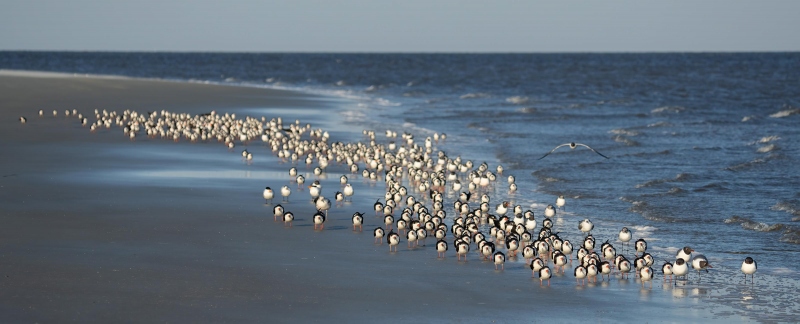
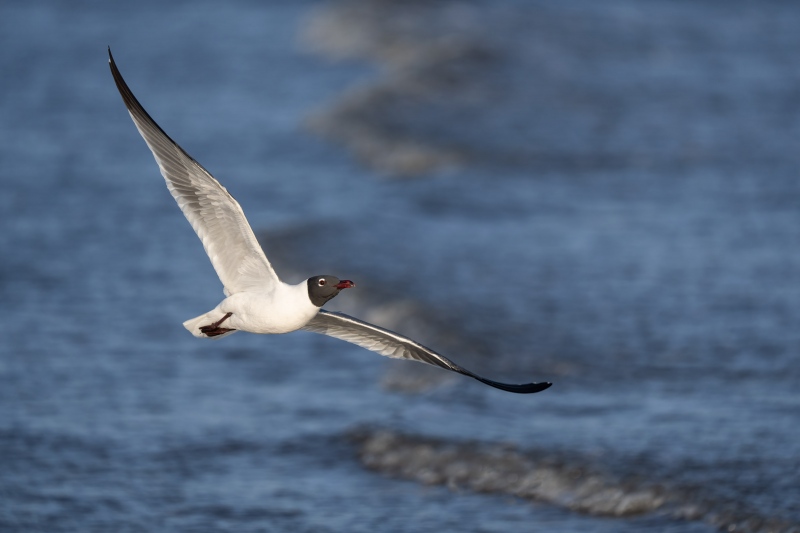
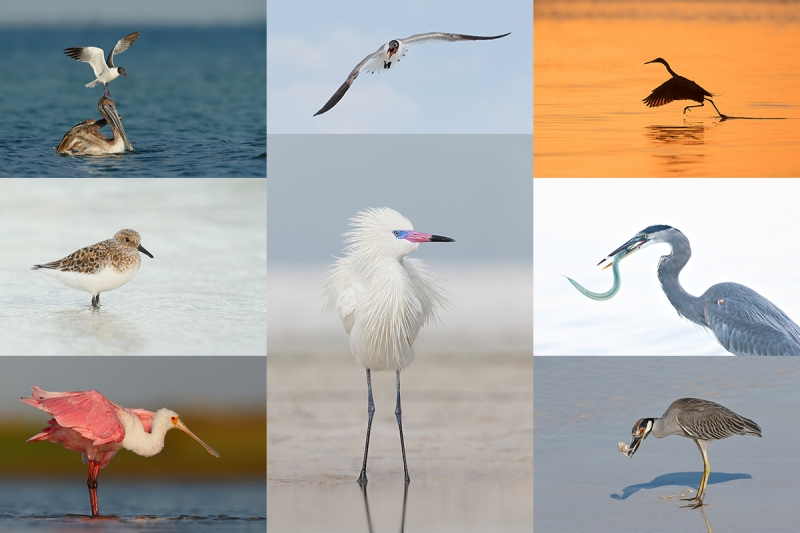
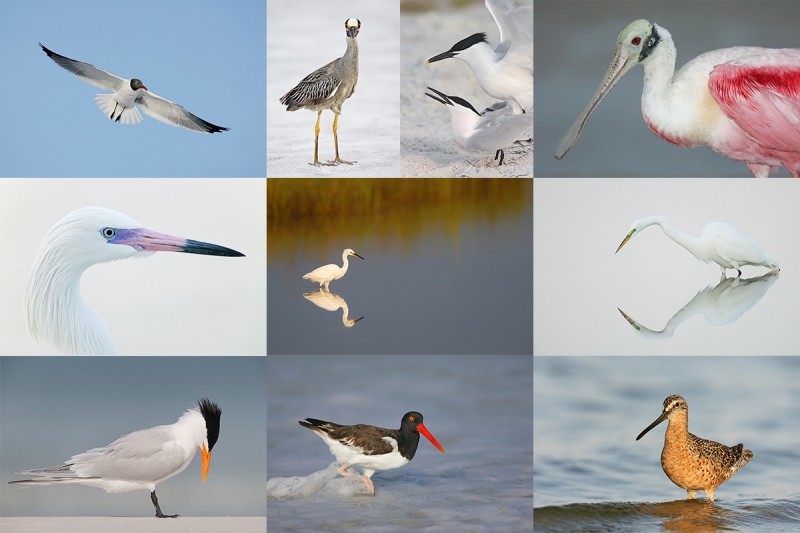
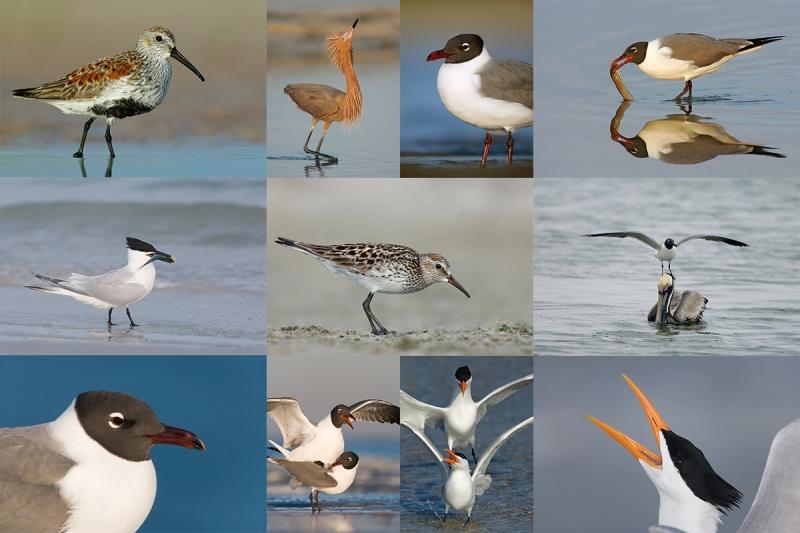
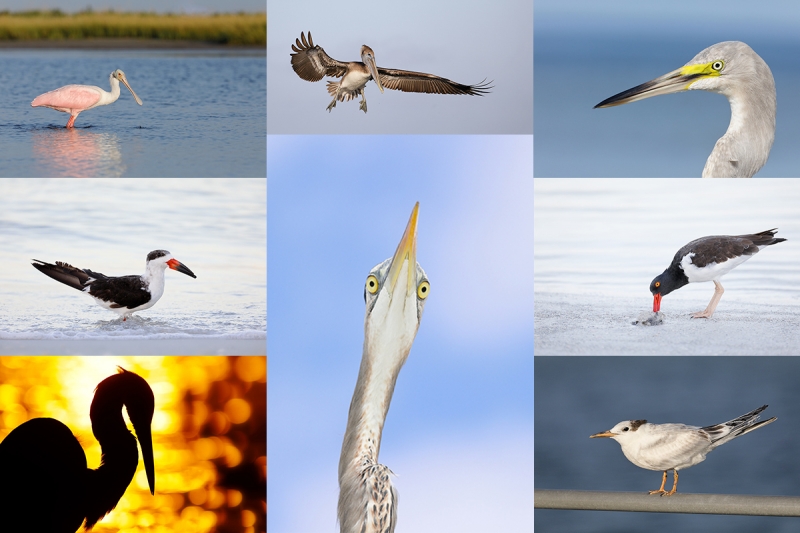













Both images are beautiful! Maybe the part that bugs you is that the Laughing Gull isn’t in flight against blue water but has a dark shadow behind?
I keep looking at 1… maybe it bugs you that the sun angle isn’t ideal (based on shadow angles of birds legs)? Though I think the photo is probably stronger as is compared to if you were dead on sun angle.
Not gonna disagree 🙁 Thanks for commenting.
with love, a
I can’t imagine anything bugging you about the skimmers/gulls/tern shot. One of my favorites that you’ve posted recently.
The laughing gull in flight is great, but I think it would be slightly stronger if the gull was just ahead of the out-of-focus wave behind it rather than just behind it.
Thanks and that’s what I think.
a
#1 has so-so many Skimmers — WOW!! And #2 is so cute with the Laughing Gull!
🙂
a
What would bug me is the dark area of the water just behind the laughing gull in flight.
You are correct sir 🙂
with love, artie
#2 head shadow under the left wing?
Nope 🙂
with love, a
Could the bug that’s biting you be the single bird in flight in the first image?
Love that!
a
Hi, Artie. We’ll, what bugs me is that today is Monday April 11, not Sunday April 10. I have no idea what bugs you about those two lovely images.
Well, at least I am consistent. Thanks as always.
with love, a
The wave in the background on the laughing gull’s left wing.
Art thanks so much for that mornings workshop. It was wonderful. I must admit I went off angle to the flock to capture bird behaviors. The biggest bird I caught was an Art Morris grey hoody. He was a bit shy but I got him in action eventually. I’ll send you the result.
You are correct sir. You are most welcome. I wish that we had had more time to spend together. The hoodie is the navy blue Bill Belichick model.
With love and looking forward to an image or two.
a
Hi Artie,
I love both of today’s featured images. If I had to guess at what bugs you, I’d say it’s the single flying laughing gull in the S-curved flock.
Cheers,
-BugBob
Nope. I like the gull. Surprised that BugBob did not see what bugged artie 🙂
with love, a
It’s has to be the cresting wave behind that is intersecting with the Laughing Gull in flight.
Bingo!
with love, a
Good morning Artie
The far wing position on the flying gull. Have to run going out to the lek. Have a great day.
Good luck with the grouse. I am fine with the far wing position of the gull but the problem is nearby. With love, a